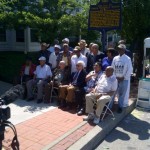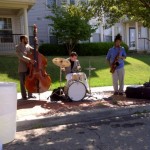The legacy of the colored/black/African American (covering the different 20th century racial nomenclature) musicians’ union locals (separate from the “regular” musicians’ union locals by racial segregation) is a rich and vastly under-reported root source for much of the creative music of the 20th century. The bare fact that such racially separate musicians union locals even existed was called into question recently when a book researcher I’ve become acquainted with visited the musicians’ union local in Wilmington, Delaware and was told by an ill-informed young person working there that separate black musicians’ union locals simply never existed(!). This ludicrous scenario came from the researcher in response to a photo I posted on Facebook from this past weekend’s commemorative event in Pittsburgh and served as a reminder of the importance of such legacy preservation activities.
This photo, which depicts what was surely A Great Day in Pittsburgh, was part of a wonderful weekend sponsored by Pittsburgh’s African American Jazz Preservation Society. I was humbled to serve as guest speaker at this Friday/Saturday event dubbed “Dedication To a Legacy”. The weekend served to commemorate the grand legacy of Pittsburgh’s African American Local 471 of the American Federation of Musicians – the separate black musicians union local necessitated by racial segregation that was founded in 1908. Besides surviving members of Local 471, which merged in the 1960s with Pittsburgh’s Local 60 of the American Federation of Musicians with somewhat disastrous consequences (a much longer story for later), and members of the historic Colored Musicians Club of Buffalo, NY, and the Clef Club of Philadelphia – both representing the historic black musicians union locals in their respective communities – participated in panel discussions and a group oral history interview. The panel discussion topics certainly give you the gist of the discussions: Segregated Musicians’ Unions: Significance, Survival and Impact; and Black Musicians Unions: Moving the Legacy Forward.
The core activity of the weekend came on Saturday morning when surviving members of Local 471 gathered on Crawford Street between Wylie & Webster Avenues in Pittsburgh’s historic African American neighborhood known as the Hill District. Surviving members took group photos beneath the shiny new marker; government, arts and labor union officials made glowing remarks, and the beautiful June morning was also enhanced by music from representatives of the next generation of Pittsburgh jazz musicians, led by bassist Miles Jackson.
It should be noted that this official marker is one of several such commemoratives scattered around the city, including one I spotted in front of the house where Art Blakey grew up, in the Hill District. Additionally there’s a condo development whose facade is imbedded with the names of some of the city’s many jazz greats, including Blakey, Ahmad Jamal, Billy Eckstine, Billy Strayhorn, Roy Eldridge, Mary Lou Williams, George Benson; and there’s a city bus emblazoned with the name of Erroll Garner; the list of Pittsburgh jazz greats is quite auspicious.


